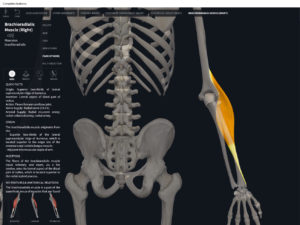Anatomy & Physiology: Muscles—Brachioradialis.
Structure.
- Origin: lateral border of distal end of humerus.
- Insertion: superior to styloid process of radius.
Function.
- Concentric action: elbow flexion; supinates and pronates forearm at radioulnar joints to neutral position.
- Reverse mover action: arm flexion at elbow; supination; pronation; medial rotation of arm at glenohumeral joint.
- Eccentric action: elbow extension.
- Isometric action: stabilization of the elbow.
- Innervation: radial nerve.
- Arterial supply: branches of brachial artery; radial artery.
Clinical Significance.
References
Biel, A. (2015). Trail guide to the body: A hands-on guide to locating muscles, bones and more.
Cedars-Sinai. (2018). Vertebrae of the spine. Retrieved from https://www.cedars-sinai.org/health-library/diseases-and-conditions/v/vertebrae-of-the-spine.html
Clark, M., Lucett, S., Sutton, B. G., & National Academy of Sports Medicine. (2014). NASM essentials of corrective exercise training. Burlington, MA: Jones & Bartlett Learning.
Jenkins, G., & Tortora, G. J. (2012). Anatomy and Physiology: From Science to Life, 3rd Edition International Stu. John Wiley & Sons.
Muscolino, J. E. (2017). The muscular system manual: The skeletal muscles of the human body.



